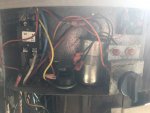So I've had my pool setup now for 2 years, this being the 3 summer I am opening it. Got the water all cleared up etc and this evening went to turn on the heater. Flipped the breaker on at the main panel, went to the disconnect by the heater and flipped that on and power is available at the heater however the unit will not actually turn on.
I redirected my valves to have the water go through the heater at this point and turned the temperature knob on it and nothing. Unit won't turn on.
Checked my pressure at the filter (sand filter) its about 12. I did a good long backwash and rinse just to be sure and still no change..
This is a Hayward HP-ABG model. Can't seem to locate anything online to check for a wiring diagram on what to troubleshoot.
Can anyone shed some light on this issue?
I redirected my valves to have the water go through the heater at this point and turned the temperature knob on it and nothing. Unit won't turn on.
Checked my pressure at the filter (sand filter) its about 12. I did a good long backwash and rinse just to be sure and still no change..
This is a Hayward HP-ABG model. Can't seem to locate anything online to check for a wiring diagram on what to troubleshoot.
Can anyone shed some light on this issue?






